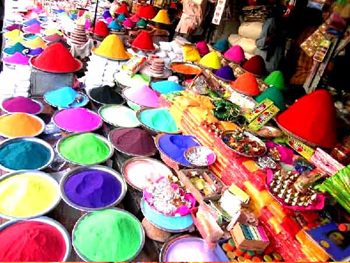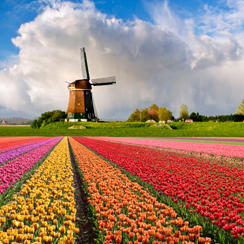Colors
By Debie Thomas
Last month, I celebrated Holi for the first time. For those unfamiliar with it, Holi is a Hindu festival — also known as the festival of colors or the festival of love — which is celebrated all over the Indian subcontinent and across the diaspora. Rooted in ancient Hindu legend, Holi commemorates the coming of spring, the victory of good over evil, and the universal brotherhood and sisterhood of human beings. Though its celebrations are playful and raucous, Holi also marks a time to mend past errors, repair broken relationships, and pay or forgive outstanding debts.
But be warned: Holi is not for the squeamish, the touch-averse, the dignified, or the expensively attired. Holi is a free-for-all carnival of colors. A bright, wet mess. Essentially, participants gather outside their homes — in parks, town squares, and driveways — arm themselves with colored powders and/or colored water, and turn each other into walking, running, laughing, screaming rainbows.
Kids use squirt guns and water balloons to splatter their friends with reds, greens, pinks, oranges and yellows. Adults smear each other's faces, arms, and clothes with colored powder, and toss buckets of tinted water over each other's heads. No one is spared, not the youngest child, not the oldest great-grandfather, and by the end of the day, everyone looks hilariously alike — distinctions of caste, class, skin color, and status covered over as completely as thick brushstrokes cover a canvas.
My husband, children, and I celebrated the holiday this year because we were invited to the home of some new friends, who host Holi festivities in their front yard every year. Being a naive newbie, I showed up wearing my favorite jeans. My husband wore nice leather shoes. 24 hours later? Those jeans weren't my favorite anymore, despite multiple cycles in the washing machine. My husband's brown shoes are now a laughable green. And my hair? It took half a bottle of shampoo to de-rainbow it.
But oh my goodness, did we ever have fun. We had a blast. Though we didn't know any of the other guests, they welcomed us with open arms, handed us water balloons, and doused us like family within thirty seconds of our arrival. I went through five or six packets of colored powder, and my kids tore through even more. We laughed, ate, talked, and shouted "Happy Holi!" until our throats hurt. It was wonderful.
But here's why I'm writing about it: I didn't grow up celebrating or even knowing about any South Asian holidays. Until I met non-Christian Indians in college, I had no idea what Diwali was. Or Onam. Or Holi. Or Eid Al-Fitr or Muharram. In my Indian-Christian family, these celebrations were considered pagan and therefore taboo. Even to educate myself about them was to trespass.
This faith-based austerity extended far beyond holidays. Also forbidden was Bharat Natyam — classical Indian dance. So were Bollywood movies. So was Indian literature, poetry, mythology, and folklore. So were brightly colored clothes. So was yoga. So was jewelry.
To this day, the piercings in my grandmother's bare ears remain — she's now one hundred years old. I don't know when her family's conversion to a more Puritannical form of Christianity forced her to give up all her "ornaments." I've heard that her jewelry — like that of so many converting women back then — was sold to pay for the construction of churches.
When my brother got married in 2003, my sister-in-law hired a hair-and-makeup artist who happened to be Hindu. I'll never forget the bewilderment on that stylist's face when she finished her work and the bridal party stood up to leave for the ceremony. "Wait!" she cried. "Where is your gold?"
My sister-in-law and I exchanged looks and rolled our eyes. We knew exactly what the stylist was thinking, and we agreed with her: why would an Indian bride get married without jewelry? Culturally speaking, it was as ridiculous as a bride walking down the aisle buck naked.
When I visit India now, I am struck by how festive and ornate its many cultures are. Song, dance, and revelry are instrinsic to South Asian worship, leisure, humor, and celebration. Its aesthetic is the very opposite of staid, drab, or monochrome. In other words, the belief that faith must always be synonymous with austerity is not an indigenous belief. It came from outside.
 |
I'm reading a book right now called The Christian Imagination: Theology and the Origins of Race, by Willie James Jennings. It's a dense, challenging read, but I'm sticking with it; it's blowing my mind. Jennings examines the intersections of Christianity, colonization, cultural imperialism, and race, to reveal just how much damage the supersessionist ideas embedded in western Christianity have wreaked around the world.
Why, he asks, has Christianity — a religion supposedly rooted in neighborly love — failed so often to bridge cultural gaps and dismantle segregation? What would it look like to embrace a truly Christlike vision of "deep joining" rather than deep division?
For me, these questions aren't academic; they're personal and urgent. I grew up having no idea that God might be okay with "pagan" things like bangles, henna, and bindis. I grew up with an Indianness that was a sad shell of itelf.
Somewhere along the line — who knows how many generations ago? the history is lost — a colonialist missionary, or a school of western-inspired theology, or the ambassadors of some North American or European Christian denomination — made contact with my family in India. I won't say the contact was categorically bad. But what resulted was a collision between cultures, and collisions always incur damage and loss. That my ancestors felt compelled to lose their culture for Christ's sake only makes the loss sadder. Who decided that "faithful" and "Indian" should be antonyms? This is a dichotomy borne of colonialism, not Christian hospitality.
On Easter Sunday, I helped the children at my church dye eggs. I watched as they dipped their hardboiled eggs, their fingers, and sometimes their sleeves into pot after pot of deep, saturated color. I watched as the blank, white eggs in their hands became works of art — multicolored symbols of spring, healing, and resurrection. As they worked, a Sunday School teacher told them about the first Easter — the ultimate triumph of good over evil.
Could I help it? Holi came powerfully to mind.
I'm not equating the two. I'm noticing. Holding my heart open. And wondering what exactly Christians gain by holding ourselves severely apart from people whose beliefs differ from our own. Is it possible that Christ's followers need to learn not only how to play host and issue invitations, but also how to receive hospitality as humble guests?
What exactly my faith requires of me in relation to other religious traditions remains an open question. I wrestle with it, hard and often. Can we have Gospel without supercession? I hope so. I hope so fiercely.
In the meanwhile, I recover what I can. I wear gold in my ears, and think of my grandmother. I watch my daughter take Bollywood dance lessons, and delight in the birthright that makes her both Indian and Christian. I celebrate Holi, and imagine Jesus tearing into those packets of color as eagerly as I did. Multi-hued baptism. I imagine it would make him smile.
Image credits: (1) FreeAllPictures.com.



